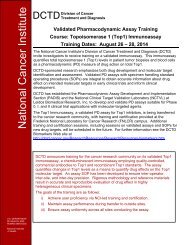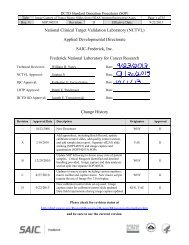National Cancer Institute - NCI Division of Cancer Treatment and ...
National Cancer Institute - NCI Division of Cancer Treatment and ...
National Cancer Institute - NCI Division of Cancer Treatment and ...
You also want an ePaper? Increase the reach of your titles
YUMPU automatically turns print PDFs into web optimized ePapers that Google loves.
target, is sensitive to the agent. To achieve<br />
efficiency, the design parameters must be<br />
carefully structured to provide adequate<br />
enrichment <strong>of</strong> the r<strong>and</strong>omly assigned<br />
patients.<br />
Freidlin B, Simon R. An evaluation <strong>of</strong> r<strong>and</strong>omized<br />
discontinuation design. J Clin Oncol<br />
2005:23;5094–8.<br />
Surrogate Endpoints<br />
In many clinical trials, it would be useful<br />
to have a surrogate endpoint that could<br />
be measured earlier or less invasively than<br />
the definitive endpoint. Three BRB statisticians—Drs.<br />
Korn, Albert, <strong>and</strong> McShane—<br />
described statistical methods for using the<br />
surrogate <strong>and</strong> definitive endpoint results<br />
from a series <strong>of</strong> previously completed trials<br />
to assess whether the surrogate endpoint<br />
could be used for a future trial.<br />
Korn EL, Albert PS, McShane LM. Assessing surrogates<br />
as trial endpoints using mixed models<br />
(with discussion). Stat Med 2005:24;163–90.<br />
Early Release <strong>of</strong> Interim Data<br />
in R<strong>and</strong>omized Clinical Trials<br />
St<strong>and</strong>ard data monitoring procedures<br />
for clinical trials only allow release <strong>of</strong><br />
interim efficacy results at the end <strong>of</strong> the<br />
trial or earlier if the results have crossed<br />
a data monitoring boundary. Drs. Korn,<br />
Hunsberger, <strong>and</strong> Freidlin, BRB, in collaboration<br />
with Drs. Malcolm Smith <strong>and</strong> Jeffrey<br />
Abrams, CTEP, suggest specific clinical<br />
situations in which it might be preferable<br />
to release interim efficacy results even<br />
though no boundary has been crossed.<br />
The situations are such that the interim<br />
release <strong>of</strong> data will not interfere with the<br />
final analysis <strong>of</strong> the trial but will potentially<br />
<strong>of</strong>fer a significant benefit to the public.<br />
22 ■ P R O G R A M A C C O M P L I S H M E N T S 2 0 0 6<br />
■ ■ ■<br />
In specific clinical situations… the interim release <strong>of</strong> data will<br />
not interfere with the final analysis <strong>of</strong> the trial but will<br />
potentially <strong>of</strong>fer a significant benefit to the public.<br />
Korn EL, Hunsberger S, Freidlin B, Smith MA,<br />
Abrams JS. Preliminary data release for r<strong>and</strong>omized<br />
clinical trials <strong>of</strong> noninferiority: a new<br />
proposal. J Clin Oncol 2005:23;5831–6.<br />
Multiple Comparisons<br />
<strong>and</strong> Clinical Trials<br />
Multiple comparison issues arise in<br />
clinical trials with subgroup analysis,<br />
multiple variables, interim monitoring,<br />
<strong>and</strong> data-driven choice <strong>of</strong> hypotheses.<br />
It has been suggested that a nonst<strong>and</strong>ard<br />
type <strong>of</strong> analysis <strong>of</strong> clinical trial data<br />
(“likelihood-based methods”) can<br />
eliminate the problems with multiple<br />
comparisons. Drs. Korn <strong>and</strong> Freidlin<br />
examine this proposition in detail <strong>and</strong><br />
find it to be lacking.<br />
Korn EL, Freidlin B. The likelihood as statistical<br />
evidence in multiple comparisons in clinical<br />
trials: no free lunch. Biom J (In press).<br />
Sample Size Calculations for<br />
Trials with Historical Controls<br />
In the 1980s, Dr. Simon <strong>and</strong> his colleagues<br />
showed that it was incorrect to ignore the<br />
variability <strong>of</strong> the historical control data<br />
when performing sample size calculations<br />
for trials using historical controls. More<br />
recently, BRB staff members have shown<br />
how these widely used methods from the<br />
1980s can be improved upon.<br />
Korn EL, Freidlin B. Conditional power calculations<br />
for clinical trials with historical controls.<br />
Stat Med (In press).<br />
Rubinstein LV, Korn EL, Freidlin B, Hunsberger S,<br />
Ivy SP, Smith MA. Design issues <strong>of</strong> r<strong>and</strong>omized<br />
phase II trials <strong>and</strong> a proposal for phase II screening<br />
trials. J Clin Oncol 2005:23;7199–206.










